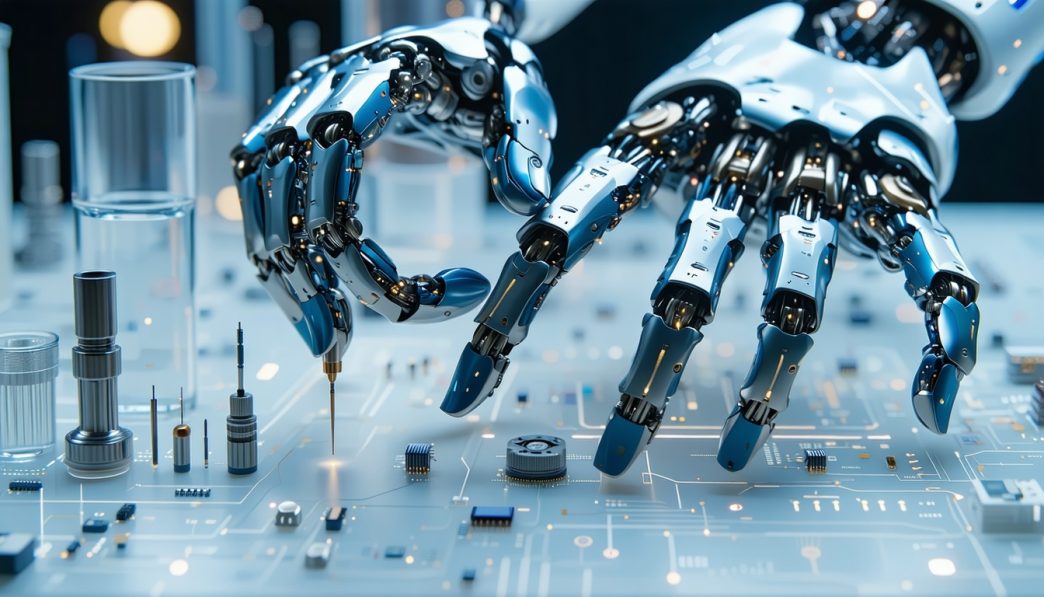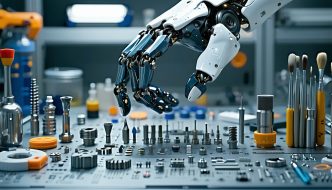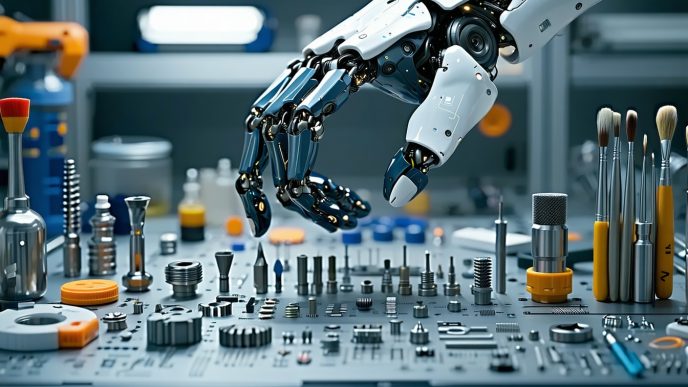Evolution of Robotics
Introduction to Robotics
Robotics has evolved significantly over the past few decades, transitioning from simple mechanical devices to complex machines capable of performing intricate tasks. This evolution includes the development of dexterous robot hands designed to mimic human-like gripping and manipulation abilities. Understanding how these advanced systems operate is essential for enthusiasts and researchers keen on the field’s possibilities.
The journey of robotics began with basic automation and has since moved towards creating robots capable of nuanced interactions with their environment. The integration of sensors and artificial intelligence allows robots to execute complex tasks that require adaptability and precision. For a deeper understanding of robotic capabilities, readers can explore the concept of robot gripping and manipulation.
Importance of Fine Motor Skills in Robots
Fine motor skills refer to the small movements of the hands and fingers that enable delicate tasks. In robotics, the ability to perform tasks similar to human dexterity is essential for effective interaction with various objects and environments. Dexterous robot hands are specially engineered to replicate these abilities, enhancing a robot’s capability to interact with the world.
The necessity for fine motor skills in robots spans multiple applications, including surgical robots, assembly lines, and domestic robots. As robots become more integrated into daily life, the demand for precise and sophisticated manipulation increases.
| Application Area | Example Tasks | Importance of Dexterity |
|---|---|---|
| Healthcare | Surgical tools manipulation | Enhances precision in delicate surgeries |
| Manufacturing | Assembly of small parts | Increases efficiency and reduces errors |
| Home Automation | Performing household chores | Facilitates a wider range of activities |
To understand the functionality and intricacies of gripping technologies, readers can refer to the latest advancements in robot grasping technology and explore how tactile sensors in robot hands contribute to sophisticated manipulation tasks. With the ongoing development in this area, the future of robotic manipulation looks promising, leading towards more versatile and capable autonomous systems.
Basics of Gripping and Manipulation
Understanding how robots interact with their environment relies heavily on the concepts of gripping and manipulation. These are essential for tasks requiring precision and dexterity, especially in applications resembling human-like actions.
The Science behind Gripping
Gripping involves the physical act of holding or clasping an object. The effectiveness of a grip depends on various factors including the shape of the object, the material of the robot’s grasping mechanism, and the application of force.
The gripping strength necessary for different tasks can vary widely. Robots designed for light tasks may require lower gripping strength compared to those handling heavy or awkwardly shaped objects. The data below summarizes typical gripping strengths found in robotic applications.
| Robot Type | Typical Gripping Strength (N) |
|---|---|
| Lightweight Robot | 5 – 10 |
| Industrial Robot | 20 – 100 |
| Heavy-Duty Robot | 150+ |
Robots often utilize tactile sensors to gauge the force applied during gripping. These sensors enhance the robot’s ability to determine how tightly to grasp an item without damaging it. For more information, refer to our article on tactile sensors in robot hands.
Manipulation and Dexterity in Robotics
Manipulation refers to how robots handle and control objects after they are grasped. Dexterity in robotics is vital for performing tasks such as assembling products, sorting objects, or conducting precision surgery. Just like human hands, dexterous robot hands must exhibit both fine motor skills and adaptability to execute complex movements.
Key elements influencing manipulation capabilities include:
- Degrees of Freedom (DoF): This refers to the number of independent movements a robot’s joints can perform. Higher DoF allows for more versatile movements.
- Adaptive Gripping Technologies: These technologies enable robots to adjust their grip based on the object’s characteristics, such as size and weight. For more about this technology, see our article on adaptive gripping in robots.
The following table illustrates the relationship between degrees of freedom and the complexity of manipulation tasks.
| Degrees of Freedom | Task Complexity | Example Tasks |
|---|---|---|
| 2 | Low | Basic lifting |
| 5 | Moderate | Simple assembly |
| 6 | High | Complex manipulation and surgery |
With the evolution of robot grasping technology, robots are becoming increasingly capable of performing tasks that require both strength and finesse. The advancements in dexterous robot hands enhance the potential applications of robots in fields such as healthcare, manufacturing, and service industries. For insights on future developments, check our article on future of robotic manipulation.
Traditional Gripping Methods
In the realm of robotics, understanding traditional gripping methods is essential for grasping how robots physically interact with their environment. This section will explore two primary approaches: simple grippers and industrial robotics.
Simple Grippers
Simple grippers are often the most basic form of gripping technology used in robots. Designed primarily for straightforward tasks, these grippers generally consist of two to three fingers that open and close to grasp objects. They function using basic mechanical principles and require minimal programming.
The simplicity of these grippers makes them cost-effective and easy to implement. However, their limited dexterity restricts them to handling only specific shapes and sizes. They are efficient for tasks such as picking and placing, which do not require intricate manipulation or sensitivity.
| Type of Simple Gripper | Description | Typical Uses |
|---|---|---|
| Parallel Gripper | Two-finger design that moves symmetrically to grasp objects. | Pick-and-place tasks in manufacturing. |
| Two-Finger Gripper | Mimics human fingers but lacks fine control. | Simple assembly jobs. |
| Vacuum Gripper | Uses suction to lift flat or smooth objects. | Packaging and material handling. |
For more detailed information, check out our article on robot grasping technology.
Industrial Robotics
Industrial robotics encompasses more complex systems that often utilize advanced gripping techniques. These robots are designed for automated tasks in various manufacturing sectors, including automotive and electronics. Industrial robots can integrate various technologies, allowing for higher efficiency and productivity.
Often equipped with custom robotic hands, these systems can perform multiple functions, such as welding, painting, and part assembly. The dexterity of industrial robot hands depends on their design and the materials used, allowing them to handle heavier loads and perform intricate tasks.
| Type of Industrial Robot Hand | Features | Applications |
|---|---|---|
| Hydraulic Gripper | Powerful gripping strength, ideal for heavy loads. | Automotive assembly and material handling. |
| Electric Gripper | Precision control with varying grip strength. | Electronics manufacturing and quality inspections. |
| Soft Gripper | Flexible materials that adapt to the object’s shape. | Delicate item handling, like packaging fragile products. |
Industrial robotics emphasize not just grip strength; they also rely on precise control and feedback mechanisms. Tactile sensors are often integrated into industrial robot hands to enhance grip and prevent dropping objects. For more about sensor technologies, visit our page on tactile sensors in robot hands.
Through these traditional gripping methods, robots have become capable of executing a variety of manipulation tasks. Despite advancements, the limitations in dexterity highlight the ongoing need for research and innovation in the field. For insights on manipulative capabilities, explore robot manipulation tasks and gripping strength in robots. Understanding these foundational technologies sets the stage for more advanced robotic solutions, such as those that leverage adaptive gripping in robots and the future of robotic manipulation.
Advancements in Robot Hands
The development of dexterous robot hands has made significant strides in recent years. These advancements are primarily categorized into bio-inspired designs and adaptive gripping technologies, both of which enhance the ability of robots to perform complex tasks with precision and dexterity.
Bio-Inspired Designs
Bio-inspired designs in robotics mimic the functionality of human and animal limbs. This approach focuses on replicating natural gripping mechanisms found in various species to improve robot dexterity. By studying how organisms interact with their environment, engineers create robotic hands that can perform tasks more accurately and efficiently.
One notable aspect of bio-inspired robot hands is the incorporation of multi-fingered designs. These robotic hands can mimic the opposable thumb mechanism of human hands, allowing for more versatile movements. This design contributes to more sophisticated manipulation tasks, such as picking up fragile items or performing intricate assembly work.
Here are some advantages of bio-inspired designs:
| Feature | Description |
|---|---|
| Flexibility | Ability to mimic complex hand movements |
| Precision | Improved accuracy in grasping objects |
| Adaptability | Can adjust grip strength based on the object’s shape |
For further insights into how robots are designed for effective gripping and manipulation, consult our article on robot gripping and manipulation.
Adaptive Gripping Technologies
Adaptive gripping technologies enable robots to adjust their grip based on the object’s size, shape, and weight. This capability is crucial for effectively handling a wide variety of items, from fragile glassware to heavy machinery parts. Many of these technologies utilize advanced sensors and algorithms to provide real-time feedback and adjustment.
Among the key components of adaptive gripping are tactile sensors, which give robots the ability to “feel” the objects they are gripping. These sensors allow robots to determine the appropriate amount of pressure to apply, thus preventing damage to sensitive items or ensuring safe handling of heavy loads.
The following table summarizes some essential features of adaptive gripping technologies:
| Feature | Description |
|---|---|
| Tactile Feedback | Enables real-time adjustments during gripping |
| Grip Strength Control | Prevents over-compression and slippage |
| Versatile Grip Patterns | Allows manipulation of various object shapes |
For more information on the role of sensors in robot hands, explore our article on tactile sensors in robot hands. Adaptive gripping not only enhances the dexterity of robots but also expands their capabilities in various applications, ranging from robot manipulation tasks to robot tool usage.
These advancements in bio-inspired designs and adaptive technologies represent a step toward creating robots that can grasp, manipulate, and operate in ways that closely resemble human dexterity. Understanding these elements helps enthusiasts and professionals alike appreciate the intricate features that define modern dexterous robot hands. For insights into future developments in robotic manipulation, check out our article on future of robotic manipulation.
Learning Fine Motor Skills
As robots strive to perform intricate tasks similar to those executed by humans, understanding the underlying processes is essential. Two significant components in this journey are machine learning and neural networks, both of which play a critical role in enabling dexterous robot hands to master fine motor skills.
Machine Learning in Robotics
Machine learning is a subset of artificial intelligence that empowers robots to learn from data and experiences without explicit programming. In the context of dexterous robots, machine learning enhances their ability to understand and adapt to various manipulation tasks.
With machine learning algorithms, robots can analyze a vast amount of sensory input and deduce the best methods for gripping and manipulating objects. This technology allows them to refine their techniques over time through trial and error, ultimately improving performance and dexterity.
Through reinforcement learning, a common machine learning approach, robots receive feedback on their performance. The robots adjust their grip strategies based on this feedback, gradually developing a keen understanding of how to interact with different materials and shapes effectively.
Neural Networks for Dexterity
Neural networks replicate the human brain’s pattern recognition capabilities, making them particularly suitable for tasks requiring finesse. In dexterous robot hands, neural networks process sensory information from their environment and assist in determining how to execute specific manipulation tasks.
The architecture of neural networks involves layers of interconnected nodes that simulate the way neurons work in the brain. By using training data, these networks can optimize gripping patterns and improve manipulation precision.
| Neural Network Types | Description |
|---|---|
| Feedforward Networks | Process information in one direction, suitable for basic tasks. |
| Convolutional Neural Networks (CNN) | Highly effective for image processing, assisting in object recognition. |
| Recurrent Neural Networks (RNN) | Useful for analyzing sequences, aiding in trajectory prediction during manipulation. |
Robotic hands equipped with neural networks can utilize tactile sensors in robot hands to gather data on the objects they handle, further enhancing their dexterity. As these systems learn and evolve, the future of robotic manipulation will revolve around sophisticated adaptive gripping techniques, enabling robots to perform a broader range of tasks.
The integration of machine learning and neural networks in robotics heralds a new era of dexterity. As researchers continue to innovate in this field, the possibilities for robots to replicate human-like fine motor skills grow exponentially. For an in-depth look at how robots can handle various manipulation tasks, check out our article on robot manipulation tasks.
Challenges and Future of Dexterous Robots
As the field of robotics advances, the development of dexterous robot hands faces several challenges that must be addressed to enhance their effectiveness and usability. Understanding these limitations is crucial for both researchers and consumers interested in the capabilities of robotic systems.
Overcoming Limitations
One of the primary challenges in creating dexterous robot hands is achieving the same level of finesse and adaptability found in human hands. Factors such as gripping strength, precision, and the ability to manipulate various objects play a significant role in this development. Current limitations include:
| Limitation | Description |
|---|---|
| Gripping Strength | Many robots struggle to maintain adequate gripping strength while manipulating delicate objects. Gripping strength in robots is a key area of focus. |
| Sensory Feedback | The lack of adequate tactile sensors makes it difficult for robots to sense their interactions with different materials. Integrating tactile sensors in robot hands is essential for improvement. |
| Complexity of Movement | Developing algorithms for precise motion control remains a challenge, particularly for tasks requiring a high degree of dexterity. Exploring robot manipulation tasks is necessary for advancing skills. |
| Cost of Production | Advanced materials and technologies to create dexterous systems can be expensive, limiting their widespread adoption. Research into lower-cost alternatives is ongoing. |
To overcome these constraints, researchers are exploring innovative designs and materials, as well as improved machine learning techniques. One promising avenue is the integration of adaptive gripping in robots that allows for real-time adjustments based on task requirements.
Potential Applications of Dexterity in Robots
The future of dexterous robots is filled with possibilities, as improvements in hand design and manipulation techniques open new applications across various industries. Some potential areas include:
| Application | Description |
|---|---|
| Medical Robotics | Dexterous robot hands can assist in delicate surgeries, providing precise control over surgical instruments. |
| Manufacturing | Robots equipped with advanced gripping capabilities can streamline production processes and reduce human error in assembly lines. |
| Home Robotics | Domestic robots can perform more complex tasks such as cooking and cleaning using enhanced manipulation skills. Research into robot tool usage for everyday tasks is crucial for consumer products. |
| Space Exploration | Dexterous robots can handle intricate tasks in unpredictable environments, such as repairing spacecraft or conducting experiments. |
| Personal Assistance | Robots capable of fine motor skills can act as personal aides, assisting with tasks that require a high level of interaction, such as feeding or grooming. |
As research continues, the focus on developing robot grasping technology will prove essential in unlocking the full potential of dexterous robots. With advances in technology, these robotic systems are expected to play a pivotal role in our daily lives, making them more capable and efficient in various applications. The future of robotic manipulation holds exciting possibilities that could transform how tasks are performed in both personal and professional environments.















